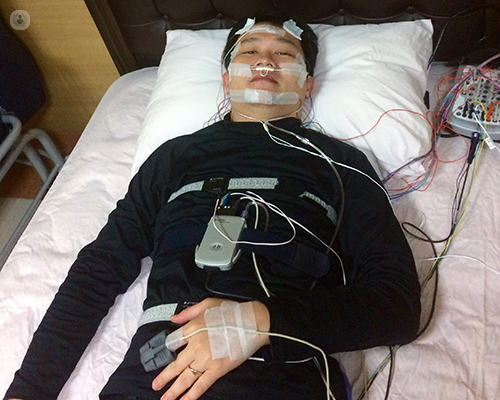Polysomnography (sleep study)
Mr Taran Tatla - Otolaryngology / ENT
Created on: 11-13-2012
Updated on: 06-29-2023
Edited by: Jay Staniland
What is a polysomnography?
Polysomnography is a non-invasive and painless test that allows the study of sleep, its phases (REM and non-REM sleep cycles) and its various alterations. It is also known as a sleep study, usually carried out by an ENT specialist.
When you fall asleep, you begin with non-REM sleep, in which an EEG will record much slower brain waves. Eventually, usually after a couple of hours of non-REM sleep, brain activity increases and you will enter REM sleep. This is when your eyes move back and forth and when most dreaming occurs. This cycle happens, on average, six times per night, which if disrupted can result in sleep disorders.

What does polysomnography consist of?
When having a sleep study, you will be given a room not dissimilar to a hotel room and asked to prepare for bed. Sensors will be stuck to your head, scalp and chest which are connected to a computer. A finger-clip measures oxygen levels in your blood.
Whilst asleep, the following are monitored:
- blood pressure
- blood oxygen levels
- breathing pattern
- brainwaves
- eye movements
- heart rate
- limb movements
- snoring or other noises made during sleep
- time taken to fall asleep
- duration of each sleep cycle
A specialist observes from another room. The sleep period is also recorded on video for further analysis. If you are being tested for sleep apnoea, you may be connected to a PAP (positive airway pressure) machine that consists of a nose-piece to provide additional air and oxygen during sleep.
Why is polysomnography done?
This test is used to diagnose possible sleep disorders, such as obstructive sleep apnoea, insomnia, narcolepsy, excessive sleepiness, restless legs syndrome or night terrors, among others. Hence, polysomnography can indicate when your sleep pattern is disrupted and why.
Preparation for polysomnography
Unless otherwise instructed by the doctor, the patient should not take any medication to sleep or consume alcohol or caffeinated beverages before the exam as they may disturb sleep.
How does it feel during polysomnography?
In general, polysomnography is performed at night, in specialised centres while the patient sleeps. Electrodes are placed on the chin, scalp and outer edge of the eyelids.
The meaning of abnormal results
Polysomnography records how often the person stops breathing for at least 10 seconds and how often the breathing is partially blocked for 10 seconds. In addition, it also records brain waves and muscle movements during sleep.
Abnormal results may mean that the patient has sleep apnoea. To make the correct diagnosis and establish the treatment, the specialist must examine other results of the polysomnography, the patient's clinical history and perform a physical examination. Therefore, a follow-up appointment will be needed to discuss the results.
